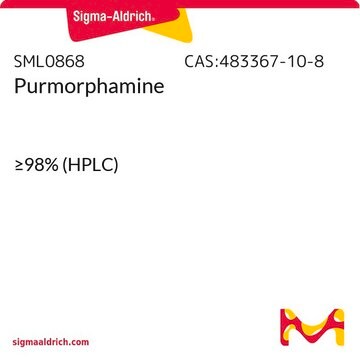14530
bisBenzimide H 33258
for fluorescence, ≥98.0% (HPLC)
Synonyme(s) :
2′-(4-Hydroxyphenyl)-5-(4-methyl-1-piperazinyl)-2,5′-bi(1H-benzimidazole) trihydrochloride, 2-[2-(4-Hydroxyphenyl)-6-benzimidazoyl]-6-(1-methyl-4-piperazyl)benzimidazole trihydrochloride, BBIH, BXI-72, HOE 33258, Hoechst 33258, NSC334072
Sélectionner une taille de conditionnement
Sélectionner une taille de conditionnement
About This Item
Produits recommandés
Qualité
for fluorescence
Niveau de qualité
Essai
≥98.0% (HPLC)
Forme
powder
Solubilité
water and ethanol: 10 mg/mL
H2O: soluble
ethanol: soluble
Fluorescence
λex 338 nm; λem 505 nm (pH 7.0)
λex 355 nm; λem 465 nm in TE buffer; DNA
Température de stockage
2-8°C
Chaîne SMILES
Cl[H].Cl[H].Cl[H].[H]O[H].CN1CCN(CC1)c2ccc3NC(=NCc3c2)c4ccc5NC(=NCc5c4)c6ccc(O)cc6
InChI
1S/C27H28N6O.3ClH.H2O/c1-32-10-12-33(13-11-32)22-5-9-25-21(15-22)17-29-27(31-25)19-4-8-24-20(14-19)16-28-26(30-24)18-2-6-23(34)7-3-18;;;;/h2-9,14-15,34H,10-13,16-17H2,1H3,(H,28,30)(H,29,31);3*1H;1H2
Clé InChI
OWRSPPSBNWJJAR-UHFFFAOYSA-N
Vous recherchez des produits similaires ? Visite Guide de comparaison des produits
Application
Springer, Volume 218 ).
Excitation max. = 346 nm
Emission max. = 460 nm
Actions biochimiques/physiologiques
Code de la classe de stockage
11 - Combustible Solids
Classe de danger pour l'eau (WGK)
WGK 3
Point d'éclair (°F)
Not applicable
Point d'éclair (°C)
Not applicable
Équipement de protection individuelle
dust mask type N95 (US), Eyeshields, Gloves
Faites votre choix parmi les versions les plus récentes :
Déjà en possession de ce produit ?
Retrouvez la documentation relative aux produits que vous avez récemment achetés dans la Bibliothèque de documents.
Les clients ont également consulté
Filtres actifs
Notre équipe de scientifiques dispose d'une expérience dans tous les secteurs de la recherche, notamment en sciences de la vie, science des matériaux, synthèse chimique, chromatographie, analyse et dans de nombreux autres domaines..
Contacter notre Service technique









